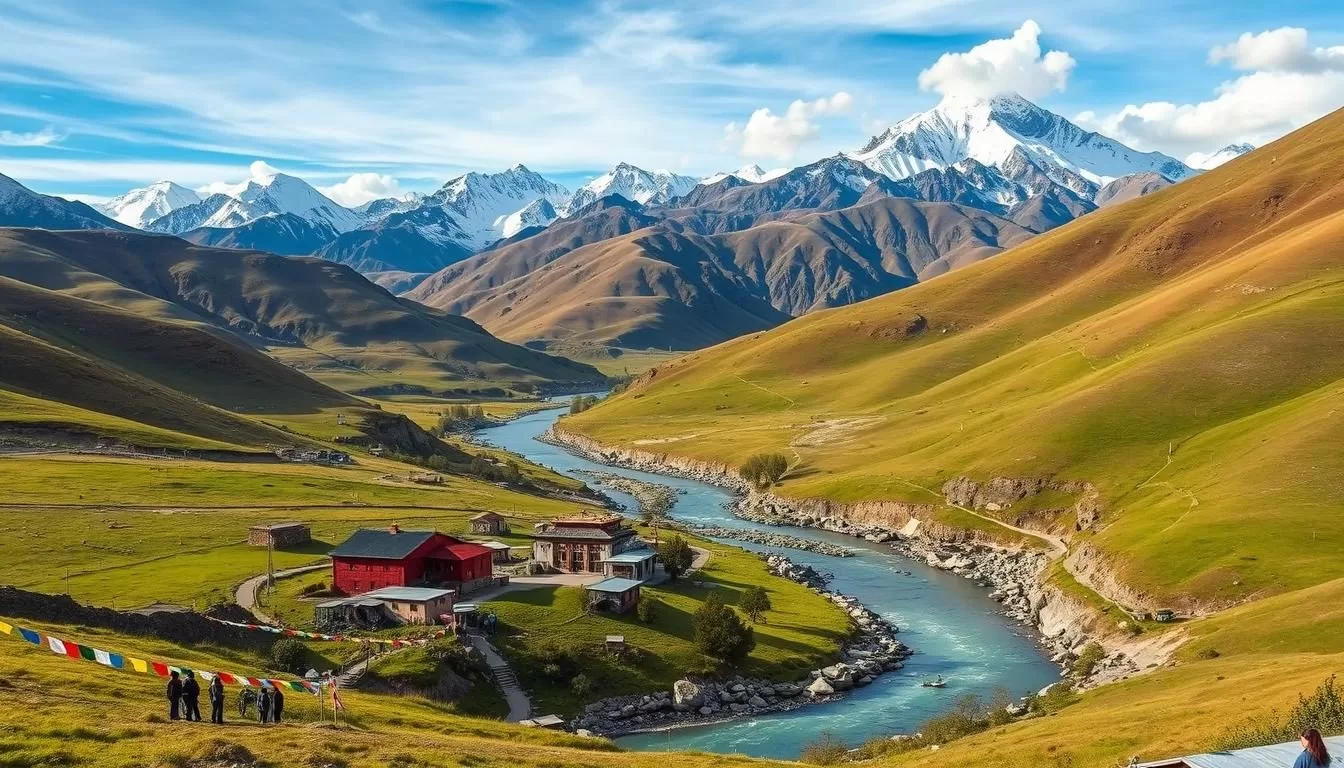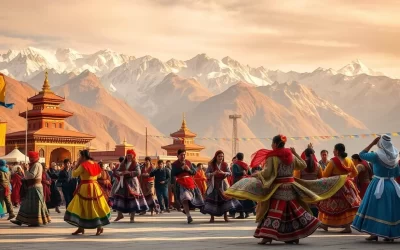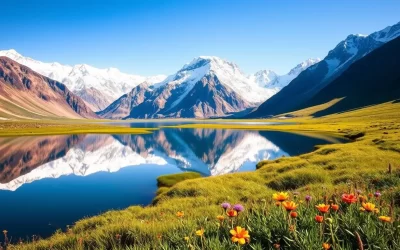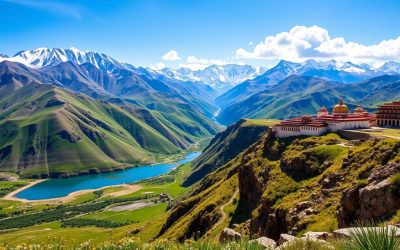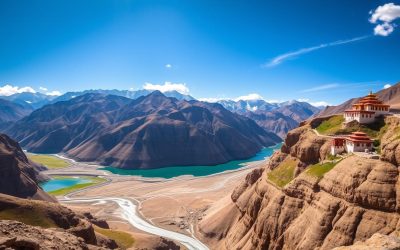✓ Accommodations✓ Flights✓ Rental Cars
Nestled in the rain shadow of the Himalayas, the high-altitude region of Ladakh is a cultural melting pot where South and Central Asian influences converge. You’ll discover a rich linguistic tapestry woven from Tibetan-derived languages and regional dialects.
The unique geography of this union territory has shaped its language development, creating a fascinating blend of cultures. As you explore Ladakh, you’ll encounter a diverse array of languages spoken across different districts and communities, reflecting the region’s position at the crossroads of multiple cultural influences.
Understanding the linguistic diversity of this region will enhance your appreciation of its cultural heritage and the challenges it faces in preserving its linguistic traditions.
The Linguistic Landscape of Ladakh
As you explore Ladakh, you’ll discover a unique linguistic landscape shaped by its extreme geography and climate. Ladakh, known as the “Roof of the World,” presents a fascinating case of how language and culture have adapted to one of the most inhospitable environments on Earth.
Geographical and Cultural Context
Ladakh’s mountains and high-altitude terrain have significantly influenced its cultural and linguistic heritage. The region’s harsh climate, characterized by low temperature and minimal rainfall, has historically limited outside contact, preserving distinct language varieties in different areas. The inhabitants of Ladakh, predominantly Buddhists in the Leh district and Muslims in the Kargil district, speak languages that reflect their religious and cultural identities.
Language Diversity in the “Roof of the World”
The altitude and weather conditions in Ladakh have created a unique linguistic environment. You can observe that:
- The isolation due to the harsh climate has preserved distinct language varieties among the people.
- Language in Ladakh follows religious and cultural lines, with Buddhist communities primarily speaking Tibeto-Burman languages.
- The mountains have created natural boundaries between language communities, leading to remarkable linguistic diversity.
- Climate change is affecting not just the physical landscape but potentially language communities as people migrate and traditional lifestyles change.
This diversity highlights the complex relationship between geography, culture, and language in Ladakh.
Ladakh (UT), India: Official and widely spoken languages
The union territory of Ladakh in India is characterized by its linguistic diversity, shaped by its geography and cultural heritage. As you explore this region, you’ll find that the languages spoken here are closely tied to the local culture and history.
Official Status of Languages in Ladakh
Ladakh is home to several languages, with Ladakhi being a prominent one among the Buddhist population of Tibetan ancestry in the Leh district. The official status of languages in Ladakh is complex, reflecting the region’s cultural and religious diversity. Ladakhi and Purik are the key languages spoken across different districts.
In the Kargil district, Purik is the principal language, closely related to Ladakhi. The creation of new districts in 2024, including Zanskar, Dras, Sham, Nubra, and Changthang, highlights the administrative recognition of linguistic and cultural variations within Ladakh.
Language Distribution Across Ladakh’s Districts
The distribution of languages in Ladakh follows geographical and religious patterns. In the Leh district, the predominantly Buddhist population speaks Ladakhi, a Tibeto-Burman language. In contrast, the Kargil district has a predominantly Muslim population that speaks Purik. Villages and towns often have distinctive speech varieties, contributing to the linguistic mosaic of the region.
| District | Predominant Language | Religious Affiliation |
|---|---|---|
| Leh | Ladakhi | Buddhist |
| Kargil | Purik | Muslim (Shi’i) |
| Zanskar | Ladakhi/Purik Variants | Buddhist/Muslim |

The Ladakhi Language: Heart of Ladakhi Identity
As you explore the cultural landscape of Ladakh, you’ll discover that the Ladakhi language is a vital part of its identity. The Ladakhi language is intricately woven into the fabric of daily life, cultural practices, and historical traditions of the region.
Origins and Classification of Ladakhi
Ladakhi is a language with deep roots in the Tibetan linguistic family. It is closely related to Classical Tibetan, a language that has significantly influenced the development of Ladakhi. The origins of Ladakhi can be traced back to the 7th century when Tibetan influence began to spread across the region.
Relationship with Classical Tibetan
The relationship between Ladakhi and Classical Tibetan is complex. While Ladakhi has evolved from Classical Tibetan, it has also developed distinct features over time. Classical Tibetan continues to be used in religious and formal contexts, whereas Ladakhi is used in everyday communication.
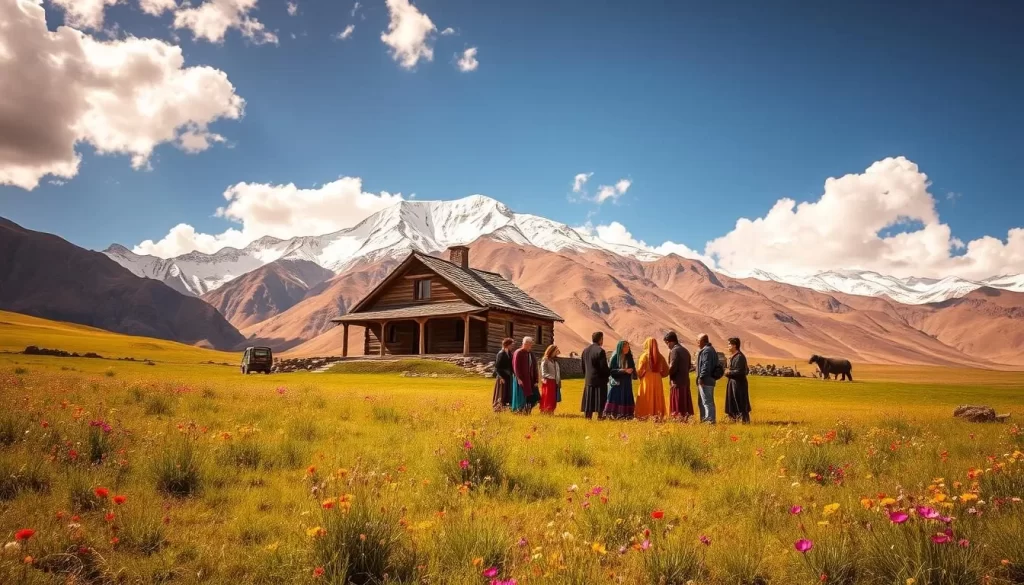
Written Form and Script
The written form of Ladakhi is a subject of ongoing debate. Traditionally, Ladakhi is written using the Tibetan script. However, there are discussions about whether to use a Ladakhized form of Classical Tibetan or to write colloquial Ladakhi in Tibetan script. A customized Wylie transliteration is commonly used for handwritten Ladakhi.
| Language/Form | Usage | Script |
|---|---|---|
| Ladakhi | Everyday communication | Tibetan script |
| Classical Tibetan | Religious and formal contexts | Tibetan script |
| Handwritten Ladakhi | Literature and informal writing | Customized Wylie transliteration |
Regional Dialects and Variations
As you explore the linguistic diversity of Ladakh, you’ll discover a rich tapestry of regional dialects and variations. The unique geography and cultural heritage of the region have contributed to the development of distinct dialects across different areas.
Lehskat: The Dialect of Leh
Lehskat is the dialect predominantly spoken in Leh, the capital city of Ladakh. It has become a sort of lingua franca among the Ladakhi people, especially in urban areas.
Shamskat: Northwestern Ladakhi
Shamskat is spoken in the northwestern parts of Ladakh. This dialect has distinct phonetic and lexical features that differentiate it from other Ladakhi dialects.
Stotskat: The Tonal Dialect of Indus Valley
Stotskat, known for its tonal characteristics, is spoken in the Indus Valley region. The dialect is notable for its complex linguistic features, shaped by the region’s history and geography.
Nubra: Northern Ladakhi Variation
Nubra is spoken in the Nubra Valley, a region known for its historical significance as part of the ancient Silk Road. You’ll find that Nubra is spoken north of Leh, in the northern valleys of Ladakh, separated from Leh by the imposing Ladakh Range and the high Khardung La pass. The extreme temperatures and geographical isolation of the Nubra Valley have contributed to the development of distinctive linguistic features. Nubra dialect speakers live in a unique ecosystem where the Shyok and Nubra rivers meet, creating a relatively fertile area surrounded by mountains. The dialect shows influences from both Ladakhi and languages from the north, reflecting historical trade connections with Central Asia across the Karakoram range. The valley‘s unique cultural and geographical characteristics have shaped the Nubra dialect, making it a fascinating example of linguistic diversity.
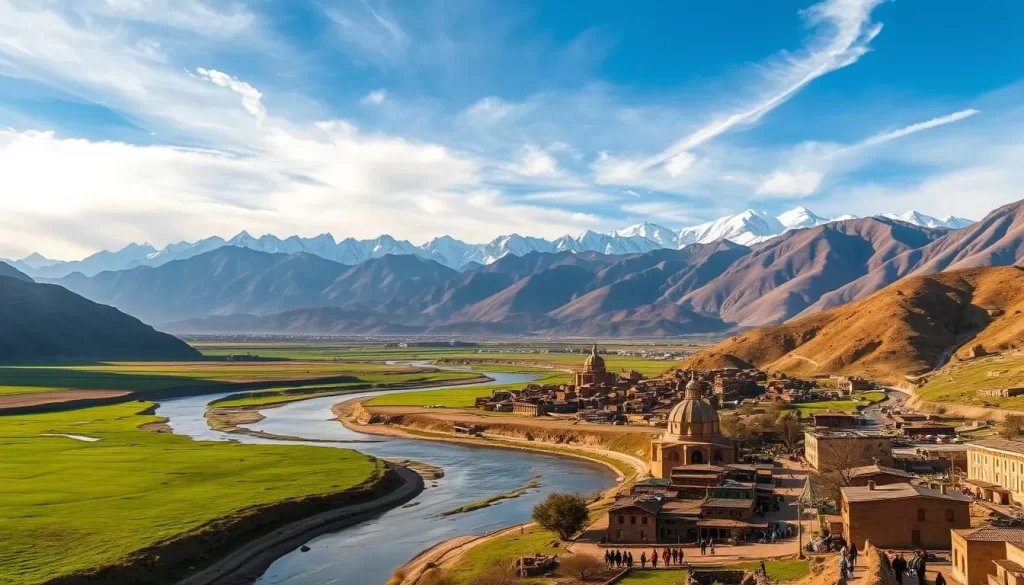
| Dialect | Region | Notable Features |
|---|---|---|
| Lehskat | Leh | Urban lingua franca |
| Shamskat | Northwestern Ladakh | Distinct phonetic and lexical features |
| Stotskat | Indus Valley | Tonal characteristics |
| Nubra | Nubra Valley | Influenced by Ladakhi and northern languages, shaped by extreme temperatures |
Other Significant Languages in Ladakh
Beyond Ladakhi, several other languages play crucial roles in the cultural tapestry of Ladakh. These languages not only enrich the region’s linguistic diversity but also reflect its historical and geographical complexities.
Purik: The Language of Kargil
Purik is a significant language spoken in the Kargil district of Ladakh. It is closely related to Ladakhi and is spoken by the Purikpa people. Purik has its own distinct grammar and vocabulary, shaped by the region’s unique cultural and historical context. The language is an integral part of the identity of the people in Kargil, and efforts are made to preserve it through local literature and cultural events.
Balti: The Western Connection
Balti is another important language in Ladakh, predominantly spoken in the western parts of the region. It has historical connections with the classical Tibetan language and is influenced by the cultural exchanges along the ancient trade routes. Balti is crucial for understanding the cultural heritage of the region, and it continues to be a vital part of the daily lives of the people in the Nubra and other western areas.
Zangskari and Its Subdialects
Zangskari is spoken in the remote Zanskar valley, which is separated from the rest of Ladakh by the imposing Zanskar Range. This language is considered by some linguists to be a dialect of Ladakhi, while others classify it as a distinct but closely related Tibetic language. Zangskari has four recognized subdialects: Stod, Zhung, Sham, and Lungna, each associated with different parts of the valley. The extreme isolation of Zanskar has helped preserve unique linguistic features. Despite its remoteness, Zanskar has become one of the popular destinations in Ladakh, potentially influencing the future development of the language through increased contact. The rugged terrain and harsh climate of the surrounding ranges have historically isolated Zanskar, contributing to the distinctiveness of Zangskari.
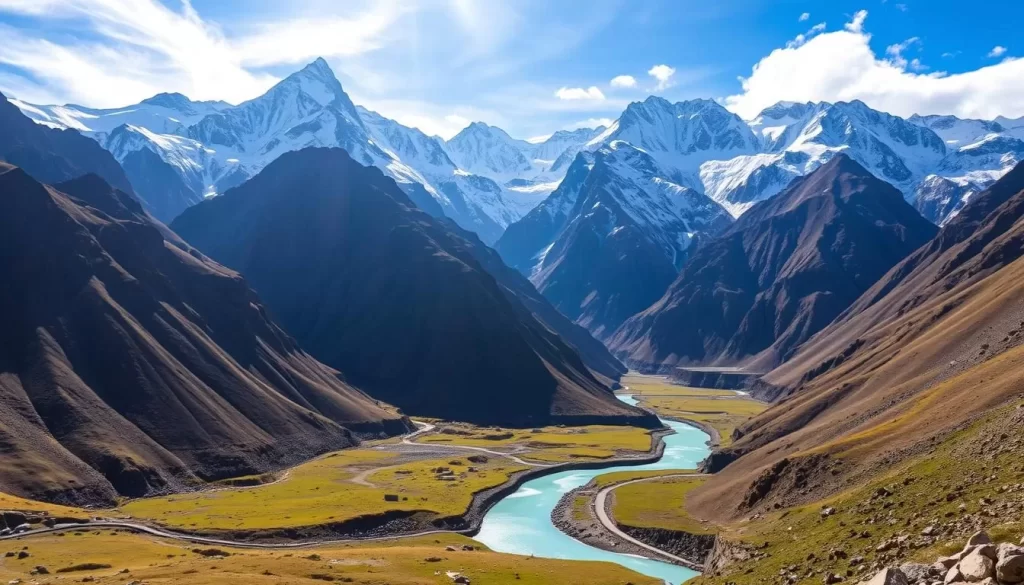
Language Education and Policy
The union territory of Ladakh presents a fascinating case study in language education and policy, reflecting its diverse linguistic and cultural tapestry. As a region with a complex history and cultural identity, Ladakh’s approach to language education is multifaceted.
School Language Curriculum
Ladakh’s school language curriculum is designed to preserve the region’s linguistic heritage while also preparing students for a broader world. Classical Tibetan is an important part of this curriculum, reflecting the region’s historical and cultural ties to Tibetan Buddhism. The curriculum also includes the local languages, such as Ladakhi and its dialects, ensuring that students are grounded in their cultural identity.
The Bhoti Movement and Constitutional Recognition
A significant development in Ladakh’s language policy is the Bhoti Movement, which seeks to have Bhoti (a term encompassing Ladakhi and related languages) included in the Eighth Schedule of the Indian Constitution. Advocates argue that this recognition would grant Bhoti official status, ensuring government support for its preservation and development. The movement has gained momentum since Ladakh became a separate union territory, with the region’s representative in parliament advocating for this recognition.
| Language | Status | Significance |
|---|---|---|
| Ladakhi/Bhoti | Local Language | Cultural Identity |
| Classical Tibetan | Part of Curriculum | Historical Ties |
Languages and Cultural Identity in Ladakh
You will discover that the languages of Ladakh play a crucial role in shaping the region’s cultural identity. The diverse linguistic traditions in Ladakh reflect the region’s complex history and cultural heritage.
Buddhist Linguistic Traditions
Buddhist communities in Ladakh have a rich linguistic tradition closely tied to Classical Tibetan. The liturgical language used in Buddhist monasteries is an essential part of their cultural practices. Over a century, this tradition has been maintained, despite external influences. The Dogra dynasty’s rule introduced new elements, but the core of Buddhist Ladakhi identity remained intact.
Muslim Communities and Language Practices
In contrast, Muslim communities, particularly in the Kargil district, have developed unique language practices. They have maintained their Tibetic languages, such as Purik, while adopting the Arabic script for writing. This blend of Tibetic languages with influences from Persian, Arabic, and Urdu has created a distinct linguistic tradition. Over time, Muslim Ladakhis have developed religious vocabulary influenced by Persian and Arabic, while retaining the basic structure of their Tibetic language. This linguistic diversity reflects the region’s cultural richness and the ability of its people to adapt and evolve.
Conclusion: Preserving Ladakh’s Linguistic Heritage
As we conclude our exploration of Ladakh’s languages, it’s clear that preserving this linguistic diversity is crucial for the region’s identity. The languages of Ladakh have evolved over time in response to extreme weather conditions and cultural exchanges along ancient trade routes.
The Indus River and Zanskar Range have played significant roles in shaping these languages. As Ladakh develops as a premier tourist destination, balancing economic growth with linguistic and cultural preservation will be crucial. Coordinated efforts from government institutions, local communities, and educational systems are necessary to preserve Ladakh’s rich linguistic heritage in this high-altitude region.
The above is subject to change.
Check back often to TRAVEL.COM for the latest travel tips and deals.
